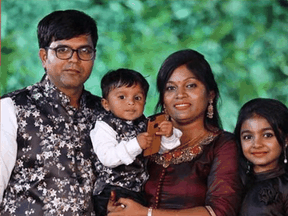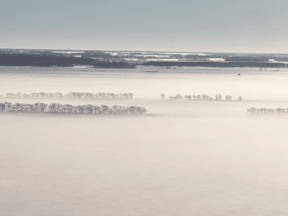By accounts from India, the father worked as a teacher, owned farmland, and the family left their village just days before being consumed by cold
Author of the article: Adrian Humphreys
Publishing date:Jan 26, 2022 •

The Patel family, who died trying to walk into the U.S. from Canada.
PHOTO BY @HIRSHAH1/TWITTER
The family of four that froze to death while trying to secretly walk into the United States from Manitoba during a blizzard were already waiting at the drop-off point in Canada when other Indian citizens arrived for the night hike across the border.
The father and mother were the oldest by a decade of the 11 migrants who gathered near Emerson, Man., on Jan. 19, for the organized illegal crossing. Their children were the youngest by far.
Most of the group were issued identical cold weather clothing by unknown smugglers: new winter coats with fur-trimmed hoods, gloves, ski masks and insulated rubber boots, all of it black.
The conditions were frightful, even for those accustomed to a prairie blizzard. The temperature hovered around -35C with the blowing snow and bleak darkness of a featureless remote route, as the group headed toward the border, about 9:30 at night.
While seven made it to safety, snatched from the cold by U.S. Border Patrol officers the next day, after more than 11 hours of walking, the family of four, including a toddler and an older child, didn’t even make it out of Canada.
The family was apparently not impoverished, as is the common perception of smuggled migrants, nor were they failed immigrants who lost a battle to stay in Canada, as is the perception of some migration experts.

Man charged in human smuggling plot in which family died to be released from jail

They walked for hours in the frozen prairie darkness, and four didn't make it
By accounts from India, they were from a large and supportive family with some assets, the father working as a teacher and owning farmland, and left their village just days before being consumed by the cold.
Indian media have identified the victims as Jagdish Patel, 35, his wife, Vaishali, 33, their daughter Vihanga, 12, and son Dharmik, 3. The family left Dingucha, a village of 3,000 people in the state of Gujarat.
The information, in multiple publications, has not been confirmed by Canadian, U.S. or Indian officials.
An online prayer service for the Patel family was held Monday by about 250 ex-pats from Gujarat in Canada, organized by Hemant Shah in Winnipeg.
“What has happened is shocking. It is very devastating,” Shah said, growing emotional. He doesn’t know the family personally but the community is getting information from India on what happened.
“We could not believe it. With the weather now in Winnipeg, we don’t dare go out. Even thinking about the pain they might have experienced in freezing cold temperatures gives us goosebumps.”
While the Patel family includes a 12-year-old daughter, the RCMP originally said the older child was a male in their mid-teens. The original information, however, was based on an initial exam in austere conditions and could change after the post-mortem exam.

The U.S. side of the Manitoba-Minnesota border near where migrants walking from Canada were found frozen to death highlights the austere and perilous conditions. PHOTO BY U.S. BORDER PATROL
The remains of the four would have been exposed to severe cold for about 16 hours before discovery, hampering examination and identification. The RCMP said investigators need to have “100 per cent certainty” on identification, and notified their next of kin, before releasing identity information.
The family was a demographic anomaly within the group of migrants.
The others are all in their late teens and early 20s, said Chief Patrol Agent Anthony S. Good, of the U.S. Border Patrol’s Grand Forks Sector, whose officers rescued them in blizzard conditions on Jan. 19.
“It’s terrible to experience those conditions for that length of time. There is an unreasonable expectation for survival at that point,” Good said. The group was wandering aimlessly when agents spotted them in a search, after a driver, allegedly in the area to pick them up, was arrested.
“They were walking, but it was hard to see anything. They were a little bit disoriented and didn’t really know which way to go. They didn’t think the trek would be that arduous.”
Two of the migrants who made it needed medical assistance. One was taken by helicopter to hospital but has survived. They were all turned over to immigration officials.
The rest of the group told U.S. officials of “a similar travel agenda” to the Patel family, as described by Indian media, Good said.
Relatives and neighbours of the Patels said the family left for Canada on a visitor’s visa about a week before the migrants were found. The family is said to have paid the equivalent of about $1,000 to an immigration agent to get them to the United States.
Documents filed in court in the case against the alleged driver, Steve Shand, 47, of Deltona, Fla., disclose that U.S. authorities are investigating a human smuggling ring in the area.
The remains of the four would have been exposed to severe cold for about 16 hours before discovery, hampering examination and identification. The RCMP said investigators need to have “100 per cent certainty” on identification, and notified their next of kin, before releasing identity information.
The family was a demographic anomaly within the group of migrants.
The others are all in their late teens and early 20s, said Chief Patrol Agent Anthony S. Good, of the U.S. Border Patrol’s Grand Forks Sector, whose officers rescued them in blizzard conditions on Jan. 19.
“It’s terrible to experience those conditions for that length of time. There is an unreasonable expectation for survival at that point,” Good said. The group was wandering aimlessly when agents spotted them in a search, after a driver, allegedly in the area to pick them up, was arrested.
“They were walking, but it was hard to see anything. They were a little bit disoriented and didn’t really know which way to go. They didn’t think the trek would be that arduous.”
Two of the migrants who made it needed medical assistance. One was taken by helicopter to hospital but has survived. They were all turned over to immigration officials.
The rest of the group told U.S. officials of “a similar travel agenda” to the Patel family, as described by Indian media, Good said.
Relatives and neighbours of the Patels said the family left for Canada on a visitor’s visa about a week before the migrants were found. The family is said to have paid the equivalent of about $1,000 to an immigration agent to get them to the United States.
Documents filed in court in the case against the alleged driver, Steve Shand, 47, of Deltona, Fla., disclose that U.S. authorities are investigating a human smuggling ring in the area.

Alleged human smuggler Steve Shand, 47, of Florida, was found by police ‘driving through blowing snow and snow drifts’ on the American side of the border.
PHOTO BY FACEBOOK
It seems a twice-monthly cross-border operation for Indian nationals, with someone dropping the migrants off on the Canadian side with winter clothing and sending them south, where someone is expected to pick them up.
The Border Patrol said officers are aware of three earlier smuggling incidents in the same area.
Footprints in the snow made by the same make of boots worn by the rescued migrants were discovered by border officers on Dec. 12, Dec. 22, 2021, and on Jan. 12.
After the Dec. 12 incident, U.S. officers spoke with RCMP officers and were told that Canadian authorities found a backpack at what appeared to be a drop-off point inside Canada. A tag inside showed a price in rupees, the currency of India.
The van driven by Shand also contained a rental agreement for a “full size passenger van” from Jan. 10 to Jan. 13. On Jan. 12, a border patrol officer found more boot prints in the snow stretching into the U.S. from Canada, also by the same brand of boots.
Cpl. Julie Courchaine, a spokeswoman with Manitoba RCMP, declined to confirm the RCMP is part of a wider investigation into human smuggling.
“We are looking at everything involved in this,” she said. “The investigation is ongoing,” including close cooperation with U.S. authorities.
The deaths are sparking debate in India, with hard questions on why so many are willing to risk so much to leave.
Newspaper accounts say the village of Dingucha and others like it are filled with advertisements and enticements for immigration to Canada, the U.S., Britain and Australia. Many make unrealistic promises of admission to Canadian universities, even without a language certificate.
The ads target the young, who dream of living abroad as a marker of success.
Judging by the age of the travellers who survived the trek last week, the ads are hitting their mark.
It seems a twice-monthly cross-border operation for Indian nationals, with someone dropping the migrants off on the Canadian side with winter clothing and sending them south, where someone is expected to pick them up.
The Border Patrol said officers are aware of three earlier smuggling incidents in the same area.
Footprints in the snow made by the same make of boots worn by the rescued migrants were discovered by border officers on Dec. 12, Dec. 22, 2021, and on Jan. 12.
After the Dec. 12 incident, U.S. officers spoke with RCMP officers and were told that Canadian authorities found a backpack at what appeared to be a drop-off point inside Canada. A tag inside showed a price in rupees, the currency of India.
The van driven by Shand also contained a rental agreement for a “full size passenger van” from Jan. 10 to Jan. 13. On Jan. 12, a border patrol officer found more boot prints in the snow stretching into the U.S. from Canada, also by the same brand of boots.
Cpl. Julie Courchaine, a spokeswoman with Manitoba RCMP, declined to confirm the RCMP is part of a wider investigation into human smuggling.
“We are looking at everything involved in this,” she said. “The investigation is ongoing,” including close cooperation with U.S. authorities.
The deaths are sparking debate in India, with hard questions on why so many are willing to risk so much to leave.
Newspaper accounts say the village of Dingucha and others like it are filled with advertisements and enticements for immigration to Canada, the U.S., Britain and Australia. Many make unrealistic promises of admission to Canadian universities, even without a language certificate.
The ads target the young, who dream of living abroad as a marker of success.
Judging by the age of the travellers who survived the trek last week, the ads are hitting their mark.
No comments:
Post a Comment